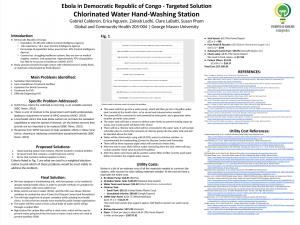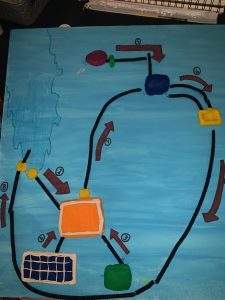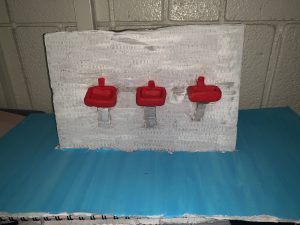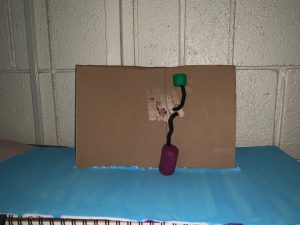May
13
Poster Presentation, Pictures of Model of Solution, and Reference List
May 13, 2019 | Uncategorized | Leave a Comment
Below, we are attaching a picture of our poster presentation. I’ll also be attaching a link to the PowerPoint file that the poster was created using. We’ll include pictures of the models of our solution, and we’ll also include the same two lists of references used on the poster.
Picture of poster:

Clickable link to download the poster as a PowerPoint file:
Ebola in DRC – Poster Presentation – GCH
Pictures of our solutions model:



List of References used in researching the specifics of the situation in DRC in order to come up with a targeted solution:
Baylor College of Medicine. (n.d.). Ebola Virus. Retrieved from https://www.bcm.edu/departments/molecular-virology-and-microbiology/emerging-infections-and-biodefense/ebola-virus
BBC News. [BBC News]. (2019, March 7). Ebola in the DR Congo warzone – BBC News [Video File]. Retrieved from https://www.youtube.com/watch?v=fGESslPLluo
Center for Disease Control and Prevention. (n.d.). How to Make Mild (0.05%) Chlorine Solution. Retrieved from https://www.cdc.gov/vhf/ebola/pdf/chlorine-solution-liquid-mild.pdf
Central Intelligence Agency. (n.d.). The World Factbook: Congo, Democratic Republic of the. Retrieved from https://www.cia.gov/library/publications/the-world-factbook/geos/print_cg.html
Doctors Without Borders. (n.d.). Ebola outbreak in DRC. Retrieved from https://www.doctorswithoutborders.org/ebola-outbreak-drc
Ebola virus disease – Democratic Republic of the Congo. (2019, April 23). Retrieved from https://www.who.int/csr/don/11-april-2019-ebola-drc/en/
FDA. (n.d.). Plumbing Controls for Commercial Food Establishments. Retrieved from https://www.accessdata.fda.gov/ORAU/PlumbingControlsCom/PCC_summary.htm
Huber, C., & Reid, K. (2019, April 16). DRC conflict: Facts, FAQs, and how to help. Retrieved from https://www.worldvision.org/disaster-relief-news-stories/drc-conflict-facts
Poon, L. (2014, September 12). How Do You Catch Ebola: By Air, Sweat Or Water? Retrieved from https://www.npr.org/sections/goatsandsoda/2014/09/12/346114454/how-do-you-catch-ebola-by-air-sweat-or-water
USAID. (2017, April 21). Global Health | Democratic Republic of the Congo. Retrieved from https://www.usaid.gov/democratic-republic-congo/global-health
UNICEF. (2019, April 18). Water, Sanitation and Hygiene in Health Care Facilities: Global baseline report 2019. Retrieved from https://data.unicef.org/resources/wash-in-health-care-facilities/
WHO (2019, April 25). Ebola virus disease – Democratic Republic of the Congo. Retrieved from https://www.who.int/csr/don/25-april-2019-ebola-drc/en/
Reference list for the rough estimate of or utility cost, including listings for all of the components of our solution:
National Tank Outlet. (n.d.). 50 Gallon Norwesco White Utility Tank. Retrieved from https://www.ntotank.com/50gallon-norwesco-white-utility-tank-x2895011?gclid=Cj0KCQjwh6XmBRDRARIsAKNInDGSXwUOQsn6KNAUjupwE5R-kVXIX0U9ZeQAfV9UCl8TvB5rYm6ZnlkaAvM6EALw_wcB
AmeraProducts, Inc. (n.d.). Alpine Hazel 402-10 Automatic Hand Dryer – White. Retrieved from https://www.ameraproducts.com/alpine-hazel-402-10-hand-dryer-white.htm?AdID=16760cm00cm03377&gclid=CjwKCAjwqqrmBRAAEiwAdpDXtNgfzhs8vOWPBj8tlLYnbGZzGsrw6U8mKE0FWq5Cob_IDZQRUdr3pRoCxP4QAvD_BwE
The Home Depot. Genova Products PVC-DWV Pipe, Schedule 40, Cellular Core, 2 in. x 10 ft.-70021F. Retrieved from https://www.homedepot.com/p/Genova-Products-PVC-DWV-Pipe-Schedule-40-Cellular-Core-2-in-x-10-ft-70021F/300282331
WholesaleSolar. (n.d.). Solar Panels. Retrieved from https://www.wholesalesolar.com/shop/solar-panels
The Home Depot. (n.d.). Glacier Bay Petite Aragon 8-3/8 in. Pedestal Sink Basin in White. Retrieved from https://www.google.com/shopping/product/10536615315174656289?lsf=seller:8740,store:3998342715601553145&prds=oid:13777026947227019350&q=sink%20bowl%20low%20cost&hl=en&ei=QvTJXIi_AuK0ggfErqfwBA&lsft=gclid:Cj0KCQjwh6XmBRDRARIsAKNInDFcDKuSbKhwPi70AdU7fJFi4MRQp9lTWS07RcEulsCQKpFLZar6C9MaApGaEALw_wcB,gclsrc:aw.ds
Katom Restaurant Supply, Inc. (n.d.). John Boos PB-FV-2LF Foot Valve w/ Goose Neck Spout. Retrieved from https://www.katom.com/416-PBFV2LF.html?gclid=Cj0KCQjwh6XmBRDRARIsAKNInDGKpRV7NkbiG7WsHwHghJVXyw3IF0yz3tsFZN-tXWlYTKNs3xY_fTYaAn_PEALw_wcB
Allied Electronics Automation. (n.d.). Dwyer Instruments CFS2-DNBPN-20. Retrieved from
Amazon. (n.d.). LNSLNM 500W Portable Power Station – 288Wh/90,000mAh Lithium Battery Backup, AC Gasless Solar Electric Generator, Uninterrupted UPS Solar Power Supply for Home/Camping/CPAP/Emergency. Retrieved from https://www.amazon.com/LNSLNM-Portable-Generator-Inverter-Camping/dp/B06WRXDK9K/ref=asc_df_B06WRXDK9K/?tag=hyprod-20&linkCode=df0&hvadid=198064505516&hvpos=1o3&hvnetw=g&hvrand=11495998718935817099&hvpone=&hvptwo=&hvqmt=&hvdev=c&hvdvcmdl=&hvlocint=&hvlocphy=9060038&hvtargid=pla-554500341032&psc=1
The Home Depot. (2019, February 23). Everbilt 1/2 in. Brass Sweat x Sweat Swing Check Valve-240-4-12-EB. Retrieved from https://www.homedepot.com/p/Everbilt-1-2-in-Brass-Sweat-x-Sweat-Swing-Check-Valve-240-4-12-EB/205816263
United States Plastic Corp. (n.d.). 30 Gallon Polyethylene Tank – 19″ Dia. x 30″ High. Retrieved from https://www.usplastic.com/catalog/item.aspx?sku=3003&gclid=Cj0KCQjwn8_mBRCLARIsAKxi0GIZTqU2zLuVB5ES6s0I8mLARHHT49L1xVegWQ_bawCHadrLYiszgLoaAjwoEALw_wcB
Google Express. (n.d.). HTH Ultimate Mineral Brilliance Chlorine Granule. Retrieved from https://express.google.com/u/0/product/9681130878275343429_6508501560989449710_121648710?utm_source=google_shopping&utm_medium=tu_prop&utm_content=eid-lsjeuxoeqt,eid-wuakzuqbuq
Google Express. (n.d.). Aqua Plumb 9115 – Carbon Water Filter Cartridge, 10. Retrieved from https://express.google.com/u/0/product/12551407453100422994_6162280658802725496_122521593?utm_source=google_shopping&utm_medium=tu_prop&utm_content=eid-lsjeuxoeqt,eid-wuakzuqbuq
RecPro. (n.d.). WFCO Artis 12v RV Potable Water Pump #PDS1RV25. Retrieved from https://www.recpro.com/wfco-artis-12v-rv-potable-water-pump-pds1rv25/?gclid=Cj0KCQjwh6XmBRDRARIsAKNInDFho218hnJdhrOxZgyRmRlTfWsPGfU0piJU3-5VCNeYc8k9Nfh1rpwaApf9EALw_wcB
May
10
Decision Matrix Four Our Different Solutions
May 10, 2019 | Uncategorized | Leave a Comment
We’re attaching an excel file of the decision matrix we used to narrow down our solutions from the original three to the one that we decided to use for the project
Decision Matrix_ Ebola
May
1
Checkpoint 3; Draft Model of Our Solution
May 1, 2019 | Uncategorized | Leave a Comment
Checkpoint 3; Ebola Outbreak in DRC Potential Solution: Chlorinated Automatic Hand Washing Faucet
For our solution on fighting Ebola, we decided to come up with a solution that would help medical professionals fight germs at a faster and more effective rate by creating a hand-washing station. This station contains products and materials that are cost effective, and energy efficient. The types of pipes we have decided to use are Polyvinyl Chloride Pipes, as they are budget-friendly, effective at carrying high water pressures, and has good longevity and performance at up to 100 years. They also are anti chorosive.
First, we would use a local source of water, such as a river or stream. Then, we decided to integrate a pipe into this body of water which will contain a carbon filter, which will filter out the water. Carbon water filters remove contaminants, odor, and bad taste. 81 chemicals can be removed from the filters. One gram of carbon is 5,000-30,000 square feet and 4 grams is equal to a football field. Due to its large surface area, carbon filters are very effective in adsorbing and removing contaminants and other substances. The concern for Ebola residing in the water is not an issue because Ebola is killed in water within seconds. This pipe, after going through a filter, will connect to a water pump. This water pump will be powered by solar panels mainly, however we also have a backup generator in case there is no direct sunlight available. After this water pump is powered, it will go through one more filter to insure that the water is pure. It will then travel through another pipe which will connect directly into a water tank. This water tank will also have another pipe which is pumping chlorine from a chlorine tank. This chlorine pipe contains a throttle valve, which will control the amount of chlorine going into this water tank to prevent too much chlorine going into this tank. After this tank reservoir is full, there will be a pipe blocker in the pipe that sits in the local body of water, which will close off when it senses this tank is full to prevent overflowing and to conserve water. After this, there will be another pipe connecting from the water tank which will lead into three valves that will connect to our sinks. After the sinks have been used, there will be one last pipe which will connect back into the river. There will also be a filter at the end of this pipe which will prevent any backflow water from infiltrating our main water tank and potentially contaminating it. As the ebola virus does not survive in water, we will not need to use a filter that filters out viruses from used water. The carbon filter is simply to help reduce bacteria since we plan to send the water back to its original source. We will follow the CDC’s guidelines in adding chlorine to water, and only create a solution with 0.05% chlorine to water, as stronger solutions are not necessary and can chlorine burns to bare skin. The solution will be installed in local medical facilities where equipment and sanitation methods are not readily available, to help stop the spread of the disease from where people are often treated. The medical workers in these facilities are often too important to the community for their clinic to be shut down, despite the lack of adequate sanitation.
The first picture is a model diagram explaining the process; where the water comes from, how we will achieve accurate pressure, etc. The second picture is a model of the actual sinks. The third picture is the other side of the wall where the sinks are installed, showing the water tank and the chlorine tank. We will install three automatic sinks, to reduce traffic should multiple people need to use the sink at once.
Key explaining each number on the diagram:
- Water comes from body of water, or water tank if no suitable water source is close by enough. This source will feed water into the water pump through pipes, and a carbon filter will be installed to ensure that the water is clean enough to drink.
- The solar panel will power the water pump as its main source, to reduce electricity costs.
- If there is no sunlight, a generator will be used as a backup source of power.
- Another carbon filter will lead another pipe out of the pump, to double-check that the water is completely pure.
- There will be a chlorine tank(in purple) that will lead chlorine into the main water tank(in blue). A throttle valve(in green) will be installed to ensure that the right amount of chlorine is in the water, and prevent over contamination.
- Pipe from the water tank, with the water-chlorine solution already mixed, will then lead into the sinks.
- Used water will connect into another pipe which will connect back into the stream.
- Another carbon filter will be installed at the end of this final pipe to ensure that no bacteria from the hands of users, or chlorine will re-enter the water source.



Sources:
Aquagenx. (n.d.). Facts about the Ebola Virus and Drinking Water. Retrieved from https://www.aquagenx.com/wp-content/uploads/2014/10/^Ebola-Virus-and-Drinking-Water-Tech-Brief.pdf
Swartz, N. (2016, October 27). How Everything in an RV Works on Wand’rly. Retrieved from https://wandrlymagazine.com/article/how-everything-in-an-rv-works/#water-system
CDC. (2015, February 27). For General Healthcare Settings in West Africa: How to Prepare and Use Chlorine Solutions. Retrieved from https://www.cdc.gov/vhf/ebola/hcp/mixing-chlorine-solutions.html
BBC News. [BBC News]. (2019, March 7). Ebola in the DR Congo warzone – BBC News [Video File]. Retrieved from https://www.youtube.com/watch?v=fGESslPLluo
Bohora, K. (2018, November 25). Pros and cons of using PVC pipe in Plumbing. Retrieved from
https://www.everestplumbing.ca/pros-and-cons-of-using-pvc-pipe-in-plumbing/
What does activated carbon water filters remove? (2019, April 7). Retrieved from https://tappwater.co/us/what-activated-carbon-remove/
Apr
24
Third Weekly Update April 22-28
April 24, 2019 | Uncategorized | Leave a Comment
This week we finalized our three solutions:
- Hand-washing stations that contain chlorine located in hospitals
- A truck that includes a smaller version of the cube
- Drones that deliver medical supplies to clinics
We created illustrations for the three solutions and explained what each one does.
Our group created a weighted decision matrix, came up with 11 criteria’s, graded each criteria and came up with our final solution: Hand-washing station.
Apr
21
Second Weekly Update April 15 – 21
April 21, 2019 | Uncategorized | Leave a Comment
After re-evaluating our initial problem of improving health care systems in DRC, we have concluded that were many limitations such as the lack of trust in these communities and many government issues.
As group we agreed our new problem is access to treatment. Together we came up with 2/3 solutions
- Creating a secure medical transportation car
- Installing a chlorinated hand washing system in hospital
- Creating a drone system whereby medical supplies can be delivered should they be needed
Apr
14
First Weekly Update – April 8-14
April 14, 2019 | Weekly Updates | Leave a Comment
- Prior to this week during our first week on the project, we developed a draft of five sub-problems based on our preliminary research that we would each individually research more about before this week. Those five problems were:
- Lack of adequate sanitation practices
- Lack of adequate healthcare facilities
- Burial ceremony practices
- Treatment for EVD
- Difficulty diagnosing EVD
- Of these problems we’ve decided to focus on the fourth one, treatment for EVD. We came to the agreement that an practical, tangible solutions was most possible in this area.
- We updated the format of this website
- We added a “Project Description” page, where newcomers to our site can get a general idea of what the problem we are tackling is.
- We added a “Team Members” page containing the names and majors of all of the people involved in the project, with their majors listed, so that readers can have some context as to who is constructing the project.
- Started to brainstorms ideas for solving our problem. We discussed specific aspects of treatment of EVD that are challenging to healthcare professionals in DRC, and came up with some rough ideas of what solutions to these problems might look like. By the end of our class session on Wednesday, April 10th, we’d decided to do more research into the specific challenges related to treating EVD so we would know more what is specifically needed.
- Based on further research, on Saturday, April 13th, we decided to focus on protective equipment for medical staff, as that seems like a major concern.